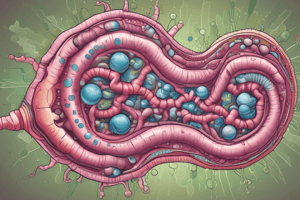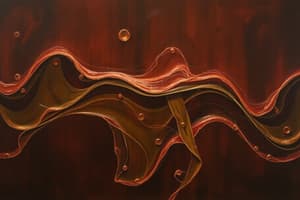Podcast
Questions and Answers
What is the primary role of lingual and gastric lipases in lipid digestion?
What is the primary role of lingual and gastric lipases in lipid digestion?
- They synthesize cholesterol from fatty acids.
- They inhibit the activity of pancreatic lipase.
- They hydrolyze triglycerides into free fatty acids. (correct)
- They emulsify lipids into smaller droplets.
What is the result of lipase activity on triglycerides as detailed in the minor digestion process?
What is the result of lipase activity on triglycerides as detailed in the minor digestion process?
- Formation of phospholipids and glycerol.
- Formation of monoglycerides and free fatty acids.
- Formation of carbohydrates and proteins.
- Formation of diglycerides and free fatty acids. (correct)
How do long chain fatty acids differ from medium chain fatty acids in terms of their carbon atom count?
How do long chain fatty acids differ from medium chain fatty acids in terms of their carbon atom count?
- Long chain fatty acids have 13-21 carbon atoms. (correct)
- Long chain fatty acids have 22 or more carbon atoms.
- Long chain fatty acids have 8-14 carbon atoms.
- Long chain fatty acids have 4-10 carbon atoms.
Which type of lipoprotein is primarily involved in the transport of lipids from the intestines to other tissues?
Which type of lipoprotein is primarily involved in the transport of lipids from the intestines to other tissues?
What could result from a deficiency in lipase during digestion?
What could result from a deficiency in lipase during digestion?
Which enzymes are primarily responsible for major lipid digestion in the duodenum and jejunum?
Which enzymes are primarily responsible for major lipid digestion in the duodenum and jejunum?
What initiates the minor digestion of triacylglycerols?
What initiates the minor digestion of triacylglycerols?
What role do bile acids play in lipid digestion?
What role do bile acids play in lipid digestion?
What do micelles transport into the intestinal epithelial cells?
What do micelles transport into the intestinal epithelial cells?
What is the primary component of chylomicrons formed in intestinal cells?
What is the primary component of chylomicrons formed in intestinal cells?
Where are bile acids synthesized?
Where are bile acids synthesized?
Which properties of bile salts contribute to their function in lipid digestion?
Which properties of bile salts contribute to their function in lipid digestion?
What substance gives bile its characteristic green color?
What substance gives bile its characteristic green color?
What is the primary role of soluble fibers in cholesterol management?
What is the primary role of soluble fibers in cholesterol management?
Which method interrupts the enterohepatic cycle to help control high blood cholesterol?
Which method interrupts the enterohepatic cycle to help control high blood cholesterol?
Which agent is known as an NPC1L1 inhibitor used to lower cholesterol?
Which agent is known as an NPC1L1 inhibitor used to lower cholesterol?
What happens to approximately 50% of cholesterol in the ileum?
What happens to approximately 50% of cholesterol in the ileum?
How do soluble fibers like oat bran fiber function in cholesterol reduction?
How do soluble fibers like oat bran fiber function in cholesterol reduction?
What condition is specifically mentioned as being secondary to stroke and ischemic heart disease?
What condition is specifically mentioned as being secondary to stroke and ischemic heart disease?
What is the effect of agents interrupting the enterohepatic cycle on cholesterol levels?
What is the effect of agents interrupting the enterohepatic cycle on cholesterol levels?
Which of the following is NOT a soluble fiber mentioned for lowering cholesterol?
Which of the following is NOT a soluble fiber mentioned for lowering cholesterol?
What is primarily responsible for the conversion of triacylglycerols to fatty acids and glycerol in capillaries?
What is primarily responsible for the conversion of triacylglycerols to fatty acids and glycerol in capillaries?
During which processes do fatty acids enter cells following chylomicron metabolism?
During which processes do fatty acids enter cells following chylomicron metabolism?
How does the size of VLDL particles relate to triacylglycerol (TG) production in the liver?
How does the size of VLDL particles relate to triacylglycerol (TG) production in the liver?
What key structural protein is present in VLDLs?
What key structural protein is present in VLDLs?
Which component is NOT a part of chylomicrons?
Which component is NOT a part of chylomicrons?
How do chylomicrons primarily navigate through the body?
How do chylomicrons primarily navigate through the body?
Which statement about apoB-48 is correct in the context of chylomicrons?
Which statement about apoB-48 is correct in the context of chylomicrons?
What role does apoC-II play in the metabolism of triacylglycerols?
What role does apoC-II play in the metabolism of triacylglycerols?
What do VLDLs primarily transport from the liver to extrahepatic tissues?
What do VLDLs primarily transport from the liver to extrahepatic tissues?
What happens to VLDLs when they encounter lipoprotein lipase?
What happens to VLDLs when they encounter lipoprotein lipase?
What is the fate of intermediate density lipoproteins (IDL) after their formation from VLDLs?
What is the fate of intermediate density lipoproteins (IDL) after their formation from VLDLs?
Which apolipoproteins do newly released VLDLs acquire from circulating HDLs?
Which apolipoproteins do newly released VLDLs acquire from circulating HDLs?
What is the role of ApoE in the metabolism of IDLs?
What is the role of ApoE in the metabolism of IDLs?
What is a significant competition that occurs regarding VLDL metabolism?
What is a significant competition that occurs regarding VLDL metabolism?
What leads to the decrease in triglyceride content in IDL particles?
What leads to the decrease in triglyceride content in IDL particles?
What percentage of IDL particles are typically cleared by the liver?
What percentage of IDL particles are typically cleared by the liver?
What is the primary composition of VLDLs?
What is the primary composition of VLDLs?
What occurs to IDL particles that are not taken up by the liver?
What occurs to IDL particles that are not taken up by the liver?
Flashcards are hidden until you start studying
Study Notes
Lipid Digestion
- Minor digestion: Lingual and gastric lipases break down medium and long chain triglycerides.
- Long chain: 13-21 carbon atoms
- Medium chain: 6-12 carbon atoms
- Targets the sn-3 ester bond in Carbon 3, forming 1,2 diacylglycerol and free fatty acids
- Important for newborn digestion of human milk.
- Major digestion: Pancreatic lipase is responsible for the majority of lipid digestion in the duodenum and jejunum.
- Formation of Mixed micelles: Bile acids, synthesized in the liver and stored in the gallbladder, are crucial for forming mixed micelles.
- Bile acids are amphipathic, acting as detergents.
- They bind to hydrophobic molecules and aid in the absorption of lipolytic products.
Lipoprotein Metabolism
- Chylomicrons: Transport triglycerides (TGs) from the intestines to extrahepatic tissues for storage/energy.
- Carry cholesterol from the intestines; primarily rich in TGs.
- Coated with Apolipoprotein B48.
- Very Low Density Lipoproteins (VLDLs): Transport triglycerides from the liver to extrahepatic tissues for storage/energy.
- Carry cholesterol from the liver; primarily rich in TGs.
- Core structural protein is apoB-100.
- VLDL synthesis occurs in the liver.
- VLDL metabolism involves the hydrolysis of TGs by lipoprotein lipase (LPL)
- Low Density Lipoproteins (LDLs):
- Derived from VLDL metabolism.
- Primarily transport cholesterol to the tissues.
- Considered "bad cholesterol"
- LDL Receptors: These receptors are responsible for recognizing and binding LDL particles, facilitating their uptake by cells.
- LDL levels are primarily influenced by genetics & diet.
- High Density Lipoproteins (HDLs):
- Transport cholesterol from the periphery of the body back to the liver, where it can be excreted.
- Considered "good cholesterol"
- HDLs help remove excess cholesterol and are thought to clear plaques from arteries.
Bile
- Bile composition:
- Bile acids/salts
- Cholesterol
- Lecithin
- Bilirubin (gives bile its green color)
- Enterohepatic Recycling:
- Bile salts and cholesterol are reabsorbed in the ileum.
- 50% of cholesterol is reabsorbed.
- Agents that interrupt the enterohepatic cycle can be used to treat high blood cholesterol.
- Soluble fibers (oat bran fiber, fruit pectin) bind to bile acids and/or cholesterol preventing their reabsorption.
- Ezetimibe: an NPC1L1 inhibitor, also known as Vytorin, is a medication that blocks the absorption of cholesterol in the intestines.
Clinical Significance
- Obesity: Can lead to complications like stroke and ischemic heart disease.
- Orlistat: A drug that inhibits pancreatic lipase, leading to decreased fat absorption and can be used to treat obesity.
- Chylomicronemia: A condition characterized by high chylomicron levels in the blood. This can lead to hypertriglyceridemia and pancreatitis.
- LDL Cholesterol: High LDL levels can contribute to atherosclerosis and cardiovascular disease.
- HDL Cholesterol: Low HDL levels can increase the risk of cardiovascular disease.
Studying That Suits You
Use AI to generate personalized quizzes and flashcards to suit your learning preferences.




